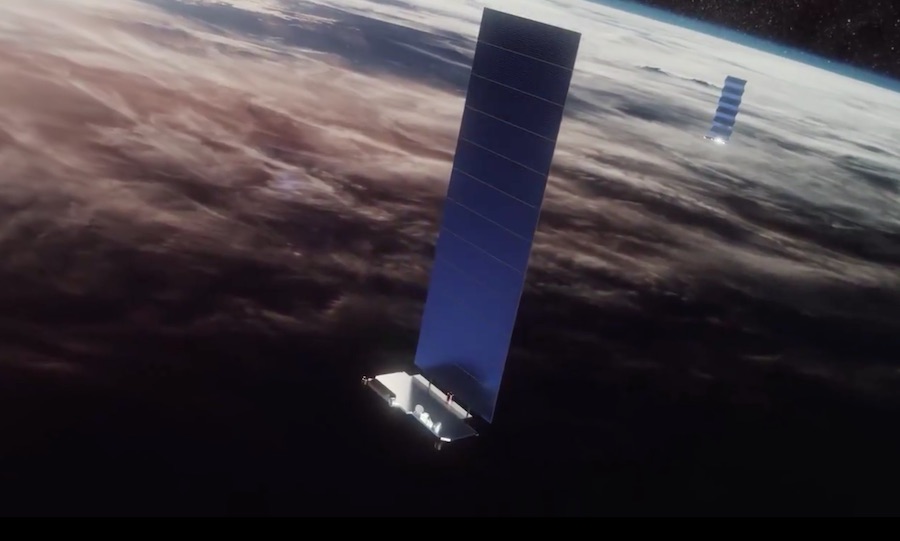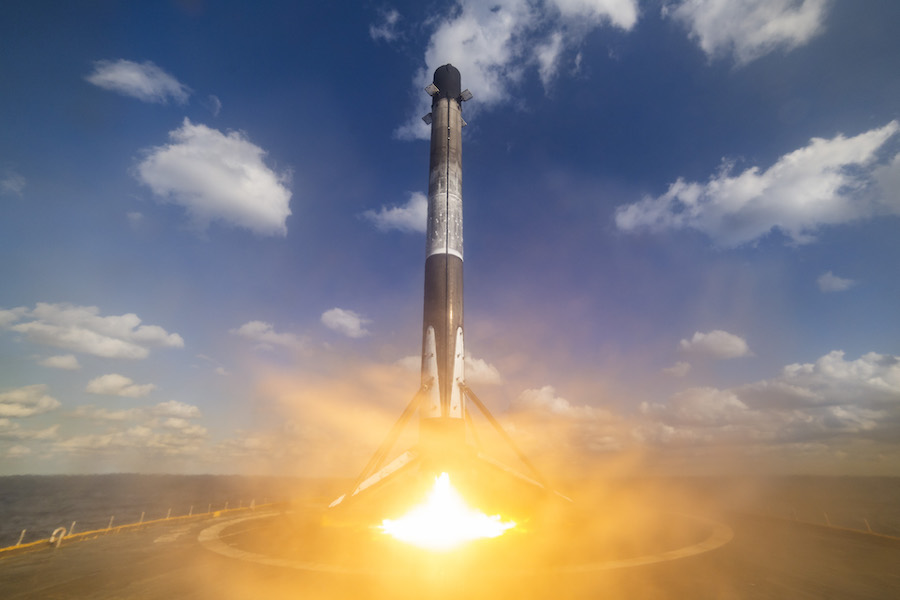SpaceX test-fires rocket for Starlink launch next week – Spaceflight Now – Spaceflight Now

SpaceX test-fired a Falcon 9 rocket with a previously-flown first stage booster Friday at NASA’s Kennedy Space Center in Florida, keeping pace for a launch scheduled next Thursday, April 23, with the next batch of 60 Starlink broadband Internet satellites.
The rocket’s nine Merlin kerosene-fed first stage engines ramped up to full throttle to produce 1.7 million pounds of thrust for several seconds at 12 p.m. EDT (1600 GMT) Friday. Hold-down restraints kept the 229-foot-tall (70-meter) rocket firmly on the ground.
A plume of rocket exhaust erupted from pad 39A’s flame trench, and SpaceX later tweeted to confirm the successful completion of the static fire test, a routine milestone during all of the company’s launch campaigns.
SpaceX says the Falcon 9 rocket is scheduled for launch at 3:16 p.m. EDT (1916 GMT) on April 23 carrying the company’s next batch of 60 Starlink broadband Internet satellites into orbit.
The launch was previously delayed from April 16.
Launch operations at Cape Canaveral are continuing amid the coronavirus pandemic, although at a reduced pace. Two launches planned in March and April, both using SpaceX Falcon 9 rockets, have been postponed at the request of SpaceX customers due to impacts from the COVID-19 viral disease.
An Argentine radar observation satellite was scheduled to launch March 30 from Cape Canaveral, and a U.S. military GPS navigation satellite was planned for launch April 29. Argentine and U.S. military officials ordered the missions delayed.
The U.S. military’s 45th Space Wing, which providers range support for launches from Florida’s Space Coast, remains open and ready to support rocket missions. Brig. Gen. Doug Schiess, the wing’s commander, said earlier this month that range personnel and contractors working at Cape Canaveral will follow strict physical distancing guidelines, and anyone working at the spaceport should wear face coverings if they are unable to maintain at least six feet of distancing from other people.

Schiess said April 9 that the Starlink launch is not “mission-critical” for U.S. national security. But he said launches should continue if teams are safe.
“We’re not taking any risk to the individuals, and that’s why each mission is being looked at individually,” Schiess said. “If we felt like this was too risky to do, then we would push (delay the launch).”
The launch next week will be the first since a Falcon 9 rocket suffered an engine failure on SpaceX’s most recent mission March 18. On that flight, one of the nine first stage Merlin engines shut down prematurely. The Falcon 9 overcame the engine anomaly and dipped into its performance reserve to place the 60 Starlink satellites on that mission into their intended orbit.
With assistance from NASA and the U.S. Space Force, SpaceX has investigated the engine failure over the last few weeks. NASA Administrator Jim Bridenstine said April 9 that engineers have a “good understanding” of the engine failure, and the agency does not anticipate it impacting plans for the first launch of astronauts on a SpaceX Crew Dragon spacecraft next month.
NASA announced Friday a target launch date of May 27 for the Crew Dragon test flight, designated Demo-2.
SpaceX has not disclosed the cause of the Merlin engine anomaly on last month’s mission, which used a first stage booster making its fifth trip to space.
The booster test-fired Friday at the Kennedy Space Center is a veteran of three previous Falcon 9 missions. It first launched in March 2019 from Florida on the first unpiloted test flight SpaceX’s Crew Dragon spacecraft, then flew again in June from Vandenberg Air Force Base in California with three Canadian Radarsat Earth observation satellites.
Most recently, the stage — designated B1051 — launched Jan. 29 from Cape Canaveral with SpaceX’s fourth batch of 60 Starlink satellites.
The rocket landed on SpaceX’s offshore drone ships after each of its previous missions.
SpaceX is also reusing a payload fairing on next week’s Starlink launch that was previously launched and recovered. The two-part payload shroud, which encloses satellites on top of the launch vehicle, flew in August 2019 with the Israeli Amos 17 communications satellite.
One of SpaceX’s ocean-going fairing recovery ships, fitted with a giant net, caught one half of the fairing after the Amos 17 launch. The other fairing half was plucked from the sea and returned to port.

The launch next week will grow the size of SpaceX’s Starlink network to more than 400 satellites, more spacecraft than in any other company’s fleet.
SpaceX has launched 362 Starlink satellites to date, including test versions. Since last May, SpaceX has launched six dedicated Falcon 9 flights for the Starlink network, each with 60 satellites on-board.
SpaceX aims to deploy more than 1,500 Starlink satellites to provide near-global Internet connectivity, serving businesses, schools, the U.S. military and private citizens. Thousands more Starlink satellites could eventually be launched by SpaceX, which has regulatory approval to operate nearly 12,000 spacecraft to beam Internet signals from space.
Each of SpaceX’s Starlink satellites is built at the company’s spacecraft development site in Redmond, Washington. The flat-panel, solar-powered relay stations each weigh about a quarter-ton, and are designed to climb into an operational orbit some 341 miles (550 kilometers) above Earth using krypton ion thrusters.
SpaceX has not publicized connectivity speeds or prices for consumer-grade connectivity through the Starlink network. But Musk gave prospective customers a taste of what they could expect.
“It will be very low latency, and we’re targeting latency below 20 milliseconds, so somebody could play a fast response video game at a competitive level,” Musk said in early March. “That’s the threshold for latency. And bandwidth? The bandwidth is a very complex question. Let’s just say somebody will be able to watch high-definition movies, play video games, and do all the things they want to do without noticing speed.”
Musk said SpaceX is not currently thinking about spinning off the Starlink project to form another company, adding that his main goal is ensuring that Starlink is a viable business after previous attempts to build large constellations of communications satellites in low Earth orbit ran into trouble.
“We need to make the thing work,” he said. “It’s real important to just set the stage here for LEO communications constellations. Guess how many LEO constellations didn’t go bankrupt? Zero.”
OneWeb, a competitor to SpaceX’s Starlink network, announced last month it was filing for bankruptcy after launching the first 74 of a planned fleet of nearly 650 Internet satellites.
“Not to bankrupt,” Musk said. “That would be a big step — to have more than zero in the not bankrupt category.”
Email the author.
Follow Stephen Clark on Twitter: @StephenClark1.





